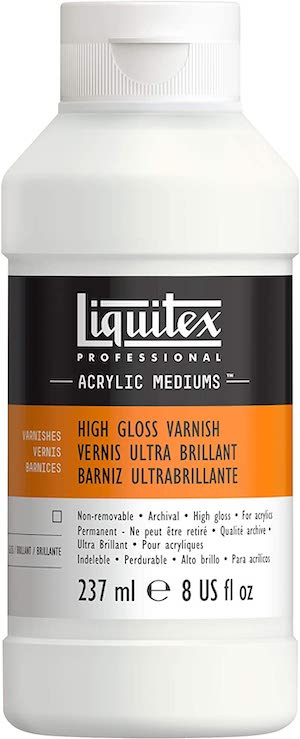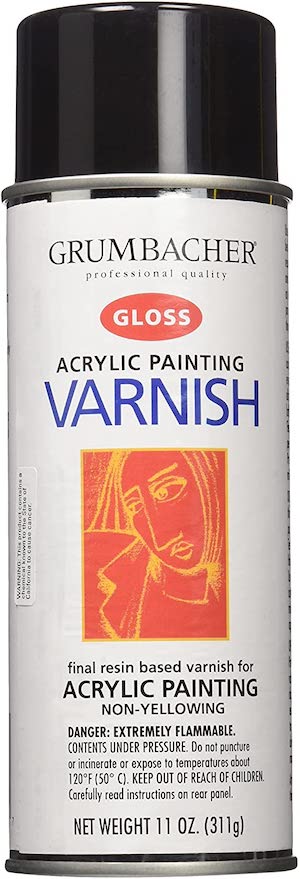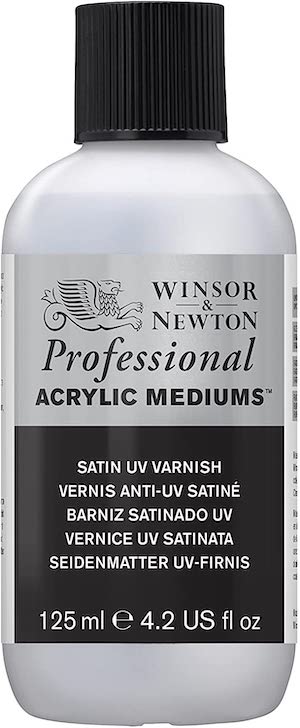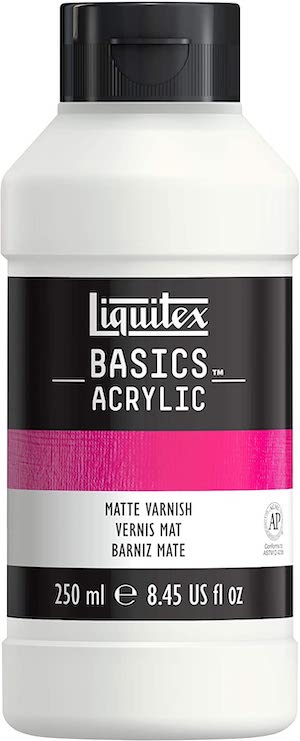So you’ve finished your acrylic masterpiece. Now what?
There are a few steps of preparation and finishing one needs to take when doing acrylic painting on canvas. These all have their different purposes, but if you want your acrylic painting to have a specific finish, and to be long-lasting, you need to seal it with a varnish.
Which is the best varnish for acrylic painting on canvas? There are a few different varnish options to choose from for acrylic painting on canvas. You need to decide whether you want to use a brush-on varnish or a spray varnish. Both have their benefits, and it will depend on what you are more familiar with, and the process you prefer.
Good work deserves good care, so don’t skip out on the right varnish for your canvas.
To help you choose the best varnish for acrylic painting on canvas, it helps to know the different options you have, and how to choose which would be the best for your piece of art!
Buyers Guide
Before having a look at the best varnishes on the market to use for acrylic painting on canvas, it helps to know what to keep in mind when you are looking for one that suits your work the best. Here are a few things to consider when choosing the best varnish:
Polymer Vs Resin
You will need to decide if you are going to use an acrylic polymer varnish or an acrylic resin varnish.
Acrylic resin varnishes are known to be glossier, stronger, and come out clearer than acrylic polymer varnish. So if you are looking for a high-gloss finish, then an acrylic resin varnish would be best for you.
It is important to note that if you are wanting to use an acrylic resin varnish, you will need to first apply an isolation coat over the painting on the canvas.
The isolation coat is even more important if you are using a matte or satin varnish. If you do not put down this initial coat, the varnish might appear cloudy.
The biggest downside to using acrylic resin varnishes is that they can be toxic if inhaled, and you will need to ensure you are in a well-ventilated room when applying the varnish. You will also need to use mineral spirits to clean your brushes once you are done.
Acrylic polymer varnishes are slightly different. They are non-toxic and can be diluted and washed with normal soap and water. You will however still need to use an isolation coat on the painting if you are wanting to use a matte or satin finish.
Satin, Gloss, or Matte Finish
You will also need to decide on the type of finish you are wanting for your acrylic painting. You have three options – gloss, satin, or matte varnish.
A gloss varnish gives a shiny, glossy finish to your painting, just as you would guess. It will bring out all the different colors in a painting, helping them to pop. There will be some shiny reflections when light hits the painting, which is not always desirable.
Satin and matte varnishes will soften the colors of a painting.
Matte varnishes are the opposite of gloss; rather than drying glossy, the finished canvas will not have that shine. Although not dull, matte varnishes finish a bit flat. However, for paintings with light, bright colors and for which a subtler, softer effect is desirable, matte could be a great option. Matte will also darken lighter colors, which is something you need to be aware of.
Satin varnishes sit somewhere between glossy and matte. Just as the name implies, the finish has a satiny look – not quite shiny or glossy, but not as flat as matte either.
You can always mix satin, glossy, and matte varnishes in order to get the look you want. There is also the option of layering the different types of varnishes to create a unique look for your artwork.
The 7 Best Varnishes For Acrylic Painting On Canvas
Once you have an idea of the varnish you should be using, it helps to know what the best options are on the market. Below are the 7 best varnishes for acrylic painting on canvas, which will all give your painting the best finish and protection possible.
| Rank | Product | Key Details |
|---|---|---|
| 1. | Liquitex High Gloss Varnish | Gloss, liquid |
| 2. | Grumbacher Acrylic Painting Varnish | Gloss, spray |
| 3. | Winsor & Newton Satin UV Varnish | Satin, liquid |
| 4. | Liquitex Basics Matte Varnish | Matte, liquid |
| 5. | Sargent Art Acrylic Gloss | Gloss, liquid |
| 6. | Krylon Clear Acrylic Coating | Gloss, spray |
| 7. | Aleene’s Acrylic Sealer | Matte, spray |
Remember to keep in mind whether you are looking for a gloss, matte, or satin finishes before you make your choice! We’ve also included a full review for each varnish below. So read on and happy varnishing!
1. Liquitex Acrylic High Gloss Varnish
The Liquitex High Gloss Varnish is used to protect the surface of a painting from environmental factors and to protect the color pigments from ultraviolet light. The varnish is also great for adding a high-gloss finish to a canvas.
This varnish is low-odor, permanent, and durable, made with water-based technology. The varnish is translucent when wet, and dries clear.
It resists against discoloring, and will not fog or yellow over time from factors such as ultraviolet light or humidity heat. The varnish can be used on paints such as heavy body paints, soft body paints, and spray paint.
When dry, the varnish is non-tacky, and hard but flexible, and is resistant to dirt retention. The varnish is also water-resistant when dry.
Not only will the varnish add a beautiful gloss finish to the acrylic painting, but it will protect the acrylic color from harsh elements, and can be used both indoors and outdoors. Lightweight, non-toxic, hard but flexible, non-tacky, non-yellowing, and water-resistant, you could not ask for more from a varnish!
If you want to create a unique finish, you can intermix the Liquitex High Gloss Varnish with other Liquitex mediums and varnishes.
2. Grumbacher Acrylic Painting Varnish
The Grumbacher Hyplar Gloss Varnish Spray is a final finishing gloss, which will give your painting ultimate shine and a pop of color.
It is a resin-based varnish, which acts as a protective coating for acrylic painting. When sprayed onto the canvas, it imparts an even gloss surface. It works to protect the painting from dirt, scuffing, and moisture.
The finish is a brilliant, but balanced gloss, which is non-yellowing, flexible, and transparent. The varnish has a quick drying time and is permanent when set.
To clean up the varnish, you will need paint thinners or a mild solvent. You will need to be in a well-ventilated area when spraying the gloss varnish onto a surface, and it should only be applied when the acrylic paint has been left to harden for 3 to 5 days.
This varnish can be used as a protective coating and for a high-gloss finish, so you are able to ensure your acrylic painting is not only long-lasting but visually stunning as well!
3. Winsor & Newton Acrylic Satin UV Varnish
The Winsor & Newton Professional Acrylic Medium Satin UV Varnish helps to protect art from airborne pollutants, fading, and UV damage.
When dried, the varnish has an even, satin finish, but it can be mixed with other sheen finishes to achieve a unique result. When it comes time to clean, you can remove the varnish with a standard varnish remover.
With extra UV-protection, you can be sure that the acrylic varnish will protect your work from environmental damage, and that it will help to keep the colors as true and bright as possible.
Available in different volumes, the Winsor & Newton Professional Acrylic Varnish will give a stunning satin finish to your paintings, and can be mixed with other varnish finishes to create a completely unique finish that will bring your artwork to life, while giving it ultimate protection!
4. Liquitex Basics Acrylic Matte Varnish
Liquitex is really such a great choice of varnish to use on acrylic paint, and they have a wide range of products to choose from to help you create a beautiful piece of artwork.
The Basics series matte varnish is simple and easy to use – and gives a permanent matte finish to your painting on canvas. It is used to protect finished paintings, helping them last for much longer.
The matte varnish can be mixed with gloss varnishes in the range, to vary the sheen of the final finish. This helps if you want both the effect of the matte varnish, but a little bit of gloss to finish it all off.
Drying to a clear finish, the varnish will not yellow or fade over time and protects the paints from dust, dirt, and UV damage.
Permanent and able to protect the finished painting, the Liquitex Basics Matte Varnish contains everything you need to lock in color with your painting, giving your piece a timeless finish and protection!
5. Sargent Art Acrylic Gloss and Varnish
Sargent Art Acrylic Gloss and Varnish is a non-toxic, safe, AP-certified varnish ideal to use on canvas to protect acrylic paints from damage and to keep the colors bright and true.
When applied to a canvas with acrylic paint, it dries to a waterproof and protective finish, and really helps the colors pop. It will not alter the colors of the paints, and instead, the gloss will help the acrylic shine.
Use the varnish over finished work to enhance and increase color depth, which brings new dimensions to your art.
You are able to tone down the gloss or create a specific finish by mixing the acrylic gloss varnish with a matte or satin varnish to suit your work and your specific art needs.
Being acid-free, it is non-toxic and will not damage your work. The acrylic varnish will not yellow over time, and will not fade, keeping the gloss finish vibrant and present for a very long time.
Clean the varnish away with water and soap before it dries, and leave it to dry before displaying your artwork proudly!
6. Krylon Galleries Clear Acrylic Coating
The Krylon ColorMaster Galleries Series Artist and Clear Coatings Aerosol is a spray-on gloss that is so easy to apply to a canvas painting, but it can also be used on plastic, metal, wood, and other surfaces.
It is ideal to use on indoor and outdoor surfaces and is resistant to outside factors that could end up damaging the painting.
One of the biggest benefits of using the ColorMaster Clear Coating spray is that it dries in 10 minutes or less, while still allowing the canvas to have a protective finish, premium coverage, and brilliant color.
The spray will not run or drip, and it will not yellow over time. It is moisture-resistant and has powerful UV-light protection.
For the ultimate protection, and ease of application, this aerosol spray is one of the better options out there!
7. Aleene’s Acrylic Sealer Matte Finish
The acrylic sealer spray from Aleene’s provides a protective, clear finish with a glossy luster that really helps your art come to life.
It offers a durable protective finish in next to no-time, which will take care of your artwork while you get to do the admiring. The spray-on formula goes on evenly and easily and dries very quickly. It contains no CFCs (chlorofluorocarbons) and is safe to use.
When applied, it goes on clear and dries matte. It helps to protect the colors and the integrity of your artwork to make it long-lasting and durable.
The clear coat varnish will not yellow over time and the colors will not fade. You can apply the coat onto items that are kept both indoors and outdoors, and the coating will offer protection to either, protecting them from the elements for an extended period of time.
How to Apply Varnish to Acrylic Canvas Painting
After spending hours painting your piece, it can be quite daunting painting a varnish onto the canvas, and there is always a chance the varnish might ruin the look of your painting. It is always recommended to do a test application.
Do a test application on a small piece of canvas to make sure that you are happy with the final result. This is even more important if you are adding an isolation coat to the painting.
To test the isolation coat and the varnish, apply them to a small canvas with a painting using similar colors to your real painting. This should give you a good idea of what the final coat will look like, and there should be no surprises!
You should not have to do a test coat every time you do a painting, but it is recommended to do one when you are using a new varnish, or a new varnish and isolation coat combination.
It’s also important to use the right brush for varnishing your painting if you are opting for a liquid varnish. You need to be sure you have control and ease of movement so that you can spread the varnish evenly across your canvas. You don’t want a poor brush that sheds bristles in the middle of varnishing, either.
Related Questions
Should I Varnish My Acrylic Paintings?
It is essential that you varnish your acrylic paintings. The varnish will help to protect the painting against dust and UV rays, and can help lock in colors to keep them from fading over time.
There are different finishes that you can choose between for your art, between satin, matte, or gloss to suit each painting and keep the overall “look” you are going for. A good varnish not only protects, but enhances, the finished work.
Can I Use Mod Podge to Seal Acrylic Paints?
Mod podge is great to use for adhering paper, fabric, and other porous materials to almost any surface. It can be used as a sealant and varnish as well, however, it is probably best for sealing and varnishing acrylic on other media.
However, it is possible to use Mod Podge to seal acrylic paints onto canvas. It is not ideal for professional work meant to last and it may affect the aging of your work. However, some hobbyists find no issues in the short term with it. If you want to try it, do a test patch first to see how it turns out.
How Soon Can You Varnish an Acrylic Painting?
While acrylics do dry quickly on the surface, you should wait at least 4-7 days for the paint to dry all the way through before varnishing.
Even if you feel the paint and it is dry to the touch by this point, it will still be wet underneath and need some more time to dry out before it is varnished.
What Can I Spray on Acrylic to Make it Waterproof?
You can spray a varnish sealer onto acrylic paint on canvas to make it more waterproof. The spray will seal the artwork and protect the paint from the elements, dirt, dust, UV light, and water stains.
You should check to see if your particular varnish specifically protects against UV rays and water; any varnish will protect against both to some extent, but not necessarily as well.
It is always best to coat your work whether it is with a spray or paint on varnish, to ensure the colors last and the piece is protected for as long as possible.
Up Next: The Best Varnish For Oil Painting







